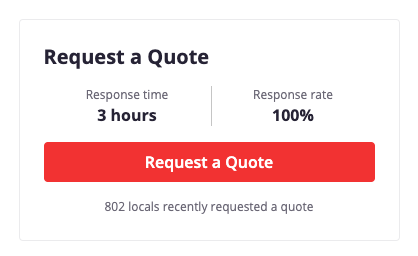Last week I wrote about moving back to Los Angeles from the Bay Area.
This week I’ll tell you how we coordinated the move, and the extra steps we took to be cautious about COVID.
If you’re planning a move soon, you may want to follow similar measures. And if you don’t want to read this but still want the advice, scroll all the way to the bottom for the TL;DR.
First, here’s what we wanted to solve for:
- Spending money where we need to (to cover packing costs), while also being mindful of budget (well, not paying for all the packing)
- Ensuring as best we could our movers would be healthy
- Staying healthy, social distancing, and doing whatever was in our control to mitigate COVID risk
And here’s the advice…
Get Quotes From Several Moving Companies
Yelp will make this easy for you. Look up moving companies in your area and start weeding out the fray by reading the ratings and reviews. Skim at least a handful of reviews for each company, paying close attention to the negative reviews. Sometimes customers will be angry about the insurance policy and blame it on the moving company. But the liability coverage moving companies are required to have is pretty minimal: they’re generally only responsible for 60 cents per pound of your possessions. So if you had some Louis Vuitton scarf that gets lost in a move, you’ll probably get less than a $1 for it.

When you see a moving company you might like, use Yelp’s Request a Quote feature to send out your requests. Do this for eight to 10 companies. Chances are, some of them won’t respond at all, and you’ll want to make sure you can compare across at least five companies.
As you start to receive quotes, pay attention to overall cost and the structure of their fees. When I was planning my move, I knew based on prior research that it’s normal to pay Bay Area movers roughly $150 per hour. I estimated that our move would take two days, or about 18 hours of work, and so I figured the move would be no cheaper than $2,700. I didn’t even factor in the cost of driving or gas, but assumed that would be a separate charge. So right off the bat, I assumed cost would start at $3,000.
As for pricing structure, I wanted to avoid hidden fees. In the end, I chose a moving company who would:
- Charge a flat or set rate for packing supplies. Most companies I spoke with charged per piece for each box or bubble wrap sheet used. I didn’t want to worry about the cost of every single supply.
- Offer a narrow cost range on their packing services. Most companies I spoke with gave a wide range that spanned $1,000. I wanted a clearer sense of cost.
- Agree to a not-to-exceed rate. This was most important to me. I didn’t want to be quoted $3,000 and then later be surprised with a $4,000 bill. I was surprised that only one moving company readily agreed to this.
Ask About Their Health and Hygiene Best Practices
For this, you’ll have to take their word for it. Many moving companies have updated their website or their Yelp page to offer more transparency into the precautions they’re taking to keep their employees and their customers safe. One company I looked at even created this very compelling YouTube video showing someone in a hazmat suit spraying down the inside of the truck. Though I was impressed, I also realized how pointless that is when you consider that coronavirus degrades pretty quickly on surfaces.
Another company I spoke with said they did fever checks of their employees. A couple companies said their movers would wear latex gloves. All of the companies I spoke with said their movers would wear masks. Though one said their employees would only wear masks during the initial walkthrough; not while they were moving our belongings. I appreciated their honesty but I also quickly ruled them out.
Ultimately, what I cared about was whether they encouraged employees to stay home while sick, and that they would commit to wearing masks throughout the move.
My husband and I already had plans to quarantine our new house for three days once the move was complete, so we weren’t worried about non-gloved hands touching our belongings. Plus, most of us don’t use gloves properly anyway. And I didn’t think it would be safe for movers to be carrying heavy furniture and boxes while wearing latex gloves without traction.
And for my part, I assured the moving company I chose that my husband would be wearing a mask as well (I would not be there for the move), and that we would have a hand washing station and hand sanitizer available for their employees to use.
Commit to X Amount of Work… Then Lower Your Expectations
In a perfect world, I would have packed up our entire apartment. I would have labeled each box with beautiful hand lettering, and I would have color-coded each box so we’d know what room each one goes in. Obviously, I didn’t do that.
I committed to packing up half the apartment, leaving the kitchen, living, and dining rooms for the movers to pack. In actuality, I probably packed up about 40% of our apartment. (Though at one point, I feared I would only actually do 10% of the packing.)
Overall, I kept my expectations low and communicated my packing progress with the moving company. It helped me get a better mental handle on moving costs, so by the time I saw the bill, I wasn’t surprised. In fact, I was relieved that the packing fees were less than I feared — thanks to my asking for a not-to-exceed rate.
Make Sure to Update Your Address with Your Bank, Credit Card Companies, and… Meal Kits
Really, just make a check list for yourself. One to two weeks prior to your move, make sure you update your address everywhere and that you forward your mail. Your bank. All your credit cards. Your meal kits and subscriptions. Your DMV registration and your voter registration.
Being the genius I am, I updated my address everywhere, even the meal kit service I sporadically use… and then I forgot to cancel that week’s meal kit delivery.
Pack a Kitchen Kit and Cleaning Kit
Your kitchen kit:
This includes all the basics you need for cooking and eating for one to two days. And this box can go in the moving truck; just mark it so you can find it easily. On day one of your new place, you might not have the time or energy to unpack and clean all your kitchen items. So make sure you have one box that’s dedicated to everything you’ll need for your first couple days. This takes some stress out of fully unpacking the kitchen.
Your cleaning kit:
You may want to keep this in your car with you. It’ll have your disinfectant wipes, your laundry detergent, your dishwashing soap. You’ll definitely want access to this first.
Plan Your Behavior and PPE on Moving Day(s)
Do you have an N95 mask you can wear while your coordinating with the movers? Or a surgical mask? Will you be able to stand in a well-ventilated area while your movers move? Coronavirus lives for up to three hours in the air, so proper ventilation and mask-wearing are important.
My husband coordinated the move, and he bought himself a face shield and goggles to wear. He also wore two masks (one surgical mask, and a cloth mask on top), and he stayed outside on the balcony while the movers worked.
Factor in Quarantine Time and Find a Place to Temporarily Stay
After spending a day or two interfacing with movers and having those movers handle all your belongings, you should quarantine your new place. Ideally, you would be able to self-isolate as well, but assuming you all wore masks and practiced social distancing, there’s a good chance you’re healthy.
For our move, we stayed with my parents for the week-and-a-half of transition. This transition factored in the three days we let our belongings quarantine. Waiting those extra days may have been overkill, but we saw no downside in waiting the extra time.
Be Considerate of Your Movers
Moving sucks. And I’m sure it especially sucks for people who have to do the moving work while wearing masks and during a pandemic. We had snacks and cold drinks for our movers, a hand-washing station and hand sanitizer available, and we made sure to withdraw cash and divvy them up into individual envelopes for their tips.
I wasn’t sure how much to tip the movers, so I looked to this random blog post because it was the first Google Search result and that seemed reasonable to me: $40 per day per mover, or $4 per hour. I ended up tipping somewhere around $5 per hour, with an extra $5 for the foreman.
TL; DR: Summary
So you can save this for later:
- Get quotes from several moving companies. And find a company who will…
- Charge a flat or set rate for packing supplies.
- Offer a narrow cost range on their packing services.
- Agree to a not-to-exceed rate.
- Ask about their health and hygiene best practices. Make sure they don’t let sick employees work, and that everyone (including you) wears a mask
- Commit to X amount of work… then lower your expectations. Assuming the movers will end up doing more work than you want will help you avoid sticker shock.
- Update your address with your bank, credit card companies, and… meal kits. Don’t forget your DMV and voter registration too!
- Pack a kitchen kit and cleaning kit. So you can start to unpack on day one and not feel too overwhelmed.
- Plan your behavior and PPE on moving day(s). Be sure to open windows for good ventilation. If you don’t have an N95 mask, consider wearing at least a surgical mask, or a surgical mask plus cloth mask. And you might as well wear some goggles and a face shield too.
- Factor in quarantine time and find a place to temporarily stay. If you can quarantine your new place for three days, that’s probably ideal.
- Be considerate of your movers. Yeah, you’re paying them, but ultimately they’re doing you a huge favor during an uncertain time. Be nice, give them drinks, give them hand sanitizer, and tip well.




